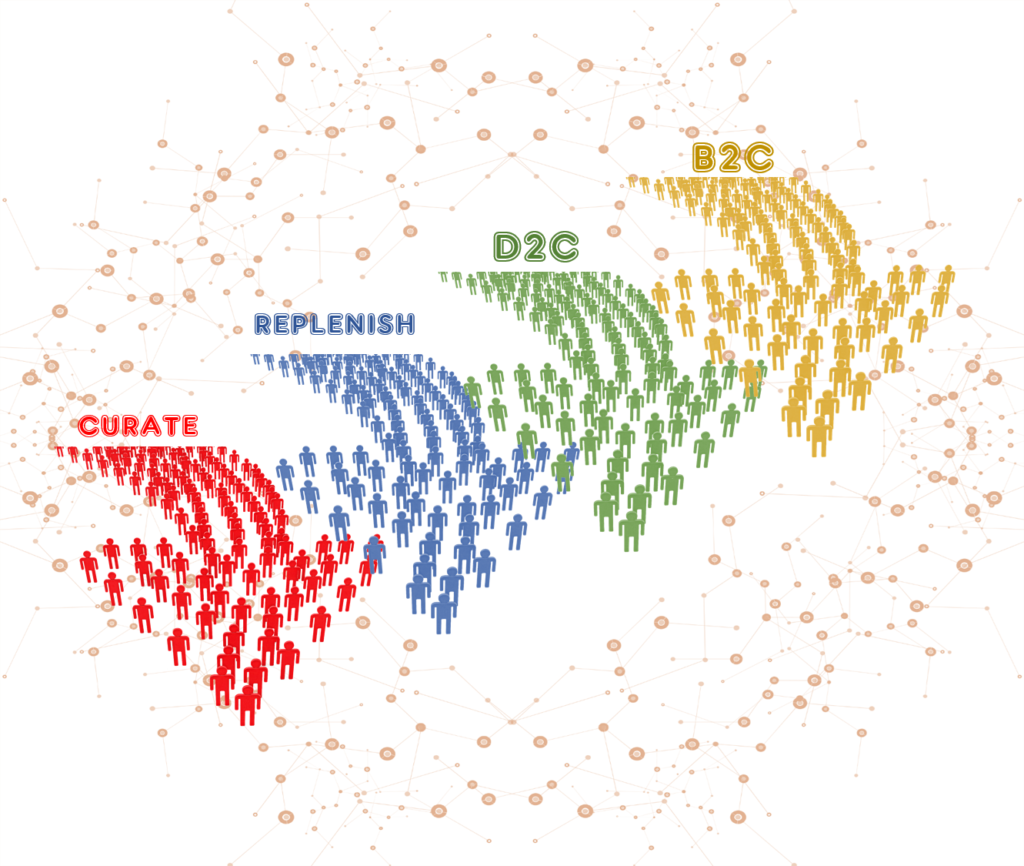The rise of e-commerce and the consumer digital path to purchase has been a nightmare for some retailers from which they can’t awake. This has been especially true for large, traditional brick-and-mortar retailers that failed to master omnichannel operations. Daphne Howland (@daphnehowland) reports one new business model that has flourished in this new retail environment is direct-to-consumer (D2C) marketing. She cites research from Diffusion which found, “Direct-to-consumer brands are capturing more of the American retail market, based on their differentiators of convenience, product quality and fast and free (or low-cost) shipping.”[1] The research also found, “A third of U.S. consumers plan to do at least 40% of their shopping from D2C companies in the next five years, and 81% say they’ll make at least one purchase from a D2C brand within the next five years.”
Direct-to-consumer business models
Deborah Abrams Kaplan (@KaplanInk) notes that direct-to-consumer business models not only affect brick-and-mortar retail operations, they also affect supply chain operations. She writes, “The four models outlined below shorten and shift the supply chain, changing the role of the middlemen.”[2]
Model 1. Direct from factories. Kaplan claims the biggest challenge for companies using this model is trying to stand out in the marketplace when selling non-branded items. This model offers low marketing and shipping costs, but it can also create tensions between manufacturers and retailers selling their products. Such relationships need to be managed carefully. Kaplan notes, “This model doesn’t entirely cut out the supply chain, as it still involves picking, packing and shipping.”
Model 2. Direct from farms. Kaplan notes this model is employed by community supported agriculture (CSA) programs. There is a lot of competition in the food arena from farmers’ markets to home delivery meal kits to click and collect programs offered by local grocers. Direct from farm programs put more money in the farmers’ pockets and consumers know exactly where their products are being grown. Kaplan adds, “The CSA model is one of the most traditional direct sales models, with customers getting consistent deliveries of produce from the farm, whether delivered to their doors or an alternate location. … While this model does not cut out the supply chain completely, it does simplify it.”
Model 3. Direct from ranches. Much like meal kit companies, meat box companies sell selected cuts of meat directly to consumers. Two of the better known companies are Crowd and Butcher Box. Kaplan explains, “In the last few years, meat box companies entered the market to offer protein directly from the ranch. Crowd Cow allows consumers to buy cuts of meat from specific ranches, while Butcher Box is a subscription service sending meat regularly from hand-picked farms. These companies are the middlemen, but unlike buying meat from a traditional butcher or grocery store where consumers likely don’t know the producer’s name, the ranch is highlighted — it’s one of the reasons for the purchase.”
Model 4. Direct from the winery. Kaplan claims, “More consumers are buying directly from wineries. … The vineyard to consumer connection isn’t new, but it is growing and changing. In 2017, the value of wines sold directly increased 15%, to a high of $2.69 billion.”
The latter three business models all deal with food and offer consumers some comfort in knowing where their food is grown and raised. As noted above, however, home delivery meal kit services offer one additional benefit — convenience. Krishna Thakker (@krishna_thakker) reports a study by Magid concluded, “[Last year, meal kit] subscriptions went up because of an emphasis on convenience, as well as the opportunities meal kits give consumers to experiment with new foods.”[3] How much growth did meal kit subscriptions enjoy last year? According the study, “During the past 12 months, meal kit subscriptions have grown 67%.”
Subscription services business models
Food and drink providers are not the only businesses offering subscription services. In another article, Kaplan asserts, “Subscription boxes are the new retail vertical — and who better to offer them than the brick-and-mortar retailers with omnichannel sales.”[4] She adds, “These legacy companies would appear to have a leg up on start-ups whose sole offerings are subscription boxes. Traditional brands have an established customer base. They have name recognition. They have an existing supply chain. They have vendor relationships.” Nevertheless, she notes, brick-and-mortar retailers are “adopting the subscription channel more slowly than start-ups.” She goes on to note a number of well-known businesses have either abandoned or paused their subscription services because of poor results. This shouldn’t be too surprising. Common sense dictates the most successful subscription services should be those providing products regularly used by consumers and that routinely need replacing (like diapers or razor blades). Surprisingly, Kaplan reports only “14% [of subscription services] use the replenishment model, restocking consumables without the customer having to proactively place orders.” The number of participants may be low because “replenishment models are competing against Amazon and Walmart, … which are selling basics like diapers on a subscribe and save model. Retailers must have a unique value proposition to compete against them.”
A more complex and difficult model to get right is a curation subscription services model. This model involves “finding unique products for each shipment.” Yet, Kaplan reports, “About 65% of subscription services use the curation model.” Those numbers are understandable if meal kits are included in the curation subscription model. Kaplan notes, “Retailers, both traditional and subscription only, are experimenting with the program elements, to determine what works and how to keep customers enrolled.” If you want to know just how difficult it can be to run a successful subscriptions service, look at the online grocery service Brandless. Jeff wells (@JeffWellsWH) reports, “Just 20% of shoppers who placed an order on the site in the fourth quarter of 2017 placed another order a quarter later, according to data from Edison Trends. Figures from Second Measure show just 11% of shoppers that placed an order last fall did so again a year later.”[5] Jeff Miller, marketing director of OceanX, told Kaplan successful subscription services need to take a number of factors into consideration including:
Pricing: “Customers should pay less for items in the subscription box than they’d pay in the store.”
Exclusivity: “Customers won’t be interested if they can buy the same thing in the store.”
Omnichannel: “Retailers have a potential advantage by integrating customers into the brand experience, including in-store loyalty programs. … It means tracking and syncing up customers from each channel and integrating returns into the process.”
Returns: “With omnichannel retailers, a customer may want to return something in the subscription box. Ideally the item can be returned or exchanged in the store, which means employees need cross training, and the store needs protocols. On the plus side, there’s the potential for additional in-store sales.”
Shipping schedules: “Some companies ship all their boxes on the same day every month or quarter. Others ship based on a customer’s start date. That can challenge the supply chain in terms of tracking and ordering.”
Customer service: “Customer satisfaction is critical in subscription sales, as it’s easy to cancel.”
Fancy fulfillment: “The boxes must be packaged nicely, which may be a change for those who currently just place merchandise in padded envelopes or plain cardboard and send it on its way.”
Personalization: “There must be flexibility in the system to please the customers. The industry is heading toward more personalization.”
Key performance indicators: “KPIs are slightly different from traditional retail.”
Summary
Retailers hoping to survive in the Digital Era must contend with new competition and consider adopting a number of potential business models which might help them better compete. And it’s not just old and new competitors retailers need to keep in mind. Professor Marion Debruyne (@MarionDebruyne), Dean of the Vlerick Business School, believes consumers should be a retailer’s primary concern. “Customer expectations are becoming increasingly more complex,” she states. “And if something is unsatisfactory, these same customers will be the first ones to announce their dissatisfaction to the entire world.”[6] New business models should better serve customers and increase their digital path to purchase satisfaction.
Footnotes
[1] Daphne Howland, “81% of consumers plan to shop direct-to-consumer brands,” Retail Dive, 8 October 2018.
[2] Deborah Abrams Kaplan, “4 direct-to-consumer models shifting the supply chain,” Supply Chain Dive, 9 October 2018.
[3] Krishna Thakker, “Meal kit subscriptions grew 67% over the past year: report,” Grocery Dive, 15 October 2018.
[4] Deborah Abrams Kaplan, “2 retail models to ‘crack the nut’ of subscription-box fulfillment,” Supply Chain Dive, 15 October 2018.
[5] Jeff Wells, “Brandless is struggling to retain shoppers: report,” Grocery Dive, 22 October 2018.
[6] Editorial Staff, “Digital’s Commercial Imperative,” IEDP, 1 February 2017.





